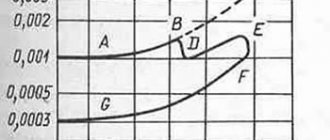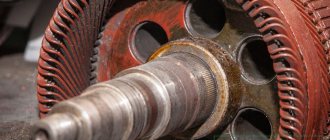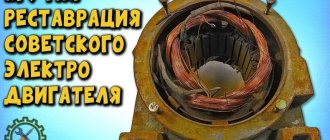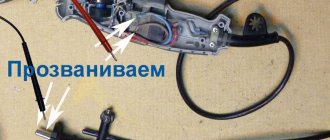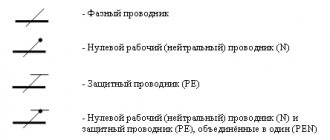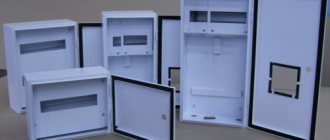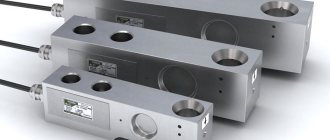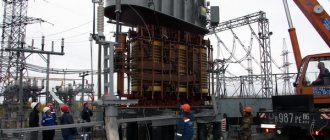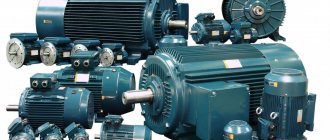Planning and preparation of repairs.
Planning of repairs of electric motors is carried out in accordance with the requirements of the “Rules for the technical operation of power plants and networks” (PTE) according to the system of scheduled preventive maintenance (PPR). Scheduled preventive maintenance includes a set of activities: maintenance and supervision during operation; periodic carrying out current and major repairs; carrying out preventive tests in accordance with the requirements of the “Electrical Equipment Testing Standards”. The frequency and timing of repairs of electric motors are linked to the repair of driven units. This helps reduce labor costs for aligning the unit with the engine, preparing the workplace by operating personnel, etc. The frequency of repairs is established by a schedule approved by the chief engineer of the enterprise. When planning the timing of major and current repairs, the technical condition of electric motors is taken into account, determined during operation (condition of bearings, heating of active parts, etc.). Annual repair schedules are drawn up by the electrical shop of the enterprise operating the electric motor and are agreed upon with the contractor performing the repair of electric motors. In accordance with the repair schedule, preparatory work is carried out, which includes: drawing up a work schedule indicating a list of devices necessary for repairing electric motors and the timing of their manufacture or delivery to the repair site; procurement of necessary materials and spare parts; preparation of fire and safety measures; development and coordination with adjacent workshops of a project for organizing special work. These works are performed by the personnel of the operating and contracting organizations. Before the electric motors are brought out for repair, all of the above preparatory work must be completed, the repair personnel must be staffed in teams, familiar with the scope of the upcoming work and the design features of the electric motors. Before starting work, the repair manager must familiarize himself with the reporting documentation on previously performed repairs on these electric motors, paying special attention to the results of previous repairs, the time spent by the bearings after replacing them and changing the lubricant, the value of air gaps and clearances in bearings, and test results . Notes on the operation of electric motors (overheating of the winding, active steel, vibration state, bearing temperature) must also be taken into account.
Electric motor diagnostics
Diagnostics means measuring certain parameters of the electric motor in operating mode and without voltage.
The following parameters are usually measured:
- Temperature
. This is a universal parameter that can say a lot about the condition of the engine. Operational measurement of the body temperature is carried out using a pyrometer or thermal imager. In some cases, a temperature sensor must be installed in the engine to provide constant temperature control. Read more about temperature conditions and electric motor overheating here. - Current
_ By comparing the rated (operating) current with the measured one, you can assess the condition of the electric motor and the drive as a whole. - Vibration
. When vibration levels increase, mechanical damage to the engine may occur. This parameter is assessed using special equipment.
With the motor de-energized, the insulation resistance is measured using a megohmmeter.
Based on the results of the listed measurements and their comparison with the nominal values, we can conclude that repairs are necessary.
Organization of workplaces for engine repair.
The most progressive form of repair maintenance of electric motors is centralized repair in workshops, industrial repair enterprises (PRP), equipped with the necessary equipment and accessories to perform all labor-intensive disassembly, assembly and repair operations. It is advisable to carry out any type of standard repair, which requires disconnecting the electric motor from the foundation and the unit, in a special workshop. Appropriate vehicles must be used to deliver electric motors to the workshop, and the workshop's lifting mechanisms must ensure their unloading. To carry out any type of repair using progressive methods that ensure high labor productivity and quality of repair, the workshop must be equipped with energy distribution (compressed air, water supply, power supply at various voltages) and include: a chamber for pneumohydraulic cleaning of electric motors, an installation for washing parts, a paint shop and drying chamber, stocks for disassembling electric motors with a vertical shaft, tilters for stators, stands for stators, stands for installing and turning rotors, a machine for balancing rotors, a machine for making groove wedges, drilling and sharpening machines, a set of pullers (hydraulic and screw) , a set of devices for removing sections of stator windings of electric motors, racks for placing components and parts when disassembling electric motors and workbenches for repairing components and parts of electric motors. When performing restoration repairs of electric motors in a workshop, in addition to the above equipment, it should include: a chamber for annealing loose windings, an installation for extracting loose windings, winding machines, an impregnation bath and an installation for filling sliding bearings. It is advisable to manufacture reserve coils for stator windings of high-voltage electric motors with micalent and other insulation at large bases that have compounding equipment, which helps ensure high quality and increase service life. In the absence of workshops for centralized repair of electric motors, repair sites can be organized. By “repair site” we mean a free area intended for reloading operations and placement of assembly units and equipment parts, repair devices and equipment during major repairs, as well as for performing repair operations that, according to technology, must be carried out near the equipment being repaired. Repair sites must be equipped with power distribution and be located within the range of the lifting equipment. Energy distributions mean distributions of oxygen, acetylene, compressed air with a pressure of (4-6)10® Pa and technical water with a pressure of 4X XY5 Pa, as well as a stationary electrical network with a voltage of 380/220 V to ensure electric welding work, connecting power tools through a frequency converter with a voltage of 36 V (220 Hz) and portable lamps through a 220/12 V transformer. The repair site must have general and local electric lighting.
Current repairs of electrical equipment
The parameters for performing routine repairs are determined based on the equipment being repaired (frequency of operation, list of operations, repair scheme). It differs for electromechanical converters and ballasts. The frequency of current repairs determines the period of major repairs, so it is important to store information about installation defects and the chosen methods for eliminating them.
The routine repair plan is also determined by the condition of the unit, the type of mechanism, and the duration of use (calculated in hours or days). The technical control process is carried out when disassembling the device, special attention is paid to the brush-commutator mechanism (applies to electric motors with direct current or asynchronous motor).
Basic operations that are performed during routine repairs:
- Cleaning filters and air purification devices, soldering the radiator (if required), descaling.
- Removing cylinder head carbon deposits (partial disassembly).
- Check the functionality of the sealing rings and piston discs; if they fail, replace them.
- Checking the efficiency of the oil filter.
- Adjusting valve clearances, charging the battery.
- Cleaning tanks and carburetors, diagnostics of the entire fuel supply system.
- Tighten the bolts; if the liners are completely worn out, install new ones.
Laboratory work No. 6 “The procedure for organizing the repair of electrical machines”
Purpose of work: To study the procedure for organizing the repair of electrical machines.
Planning of repairs of electric motors is carried out in accordance with the requirements of the “Rules for the technical operation of power plants and networks” (PTE) according to the system of scheduled preventive maintenance (PPR). Scheduled preventive maintenance includes a set of activities: maintenance and supervision during operation; periodic carrying out current and major repairs; carrying out preventive tests in accordance with the requirements of the “Electrical Equipment Testing Standards”. The frequency and timing of repairs of electric motors are linked to the repair of driven units. This helps reduce labor costs for aligning the unit with the engine, preparing the workplace by operating personnel, etc. The frequency of repairs is established by a schedule approved by the chief engineer of the enterprise. When planning the timing of major and current repairs, the technical condition of electric motors is taken into account, determined during operation (condition of bearings, heating of active parts, etc.). Annual repair schedules are drawn up by the electrical shop of the enterprise operating the electric motor and are agreed upon with the contractor performing the repair of electric motors. In accordance with the repair schedule, preparatory work is carried out, which includes: drawing up a work schedule indicating a list of devices necessary for repairing electric motors and the timing of their manufacture or delivery to the repair site; procurement of necessary materials and spare parts; preparation of fire and safety measures; development and coordination with adjacent workshops of a project for organizing special work. These works are performed by the personnel of the operating and contracting organizations. Before the electric motors are brought out for repair, all of the above preparatory work must be completed, the repair personnel must be staffed in teams, familiar with the scope of the upcoming work and the design features of the electric motors. Before starting work, the repair manager must familiarize himself with the reporting documentation on previously performed repairs on these electric motors, paying special attention to the results of previous repairs, the time spent by the bearings after replacing them and changing the lubricant, the value of air gaps and clearances in bearings, and test results . Notes on the operation of electric motors (overheating of the winding, active steel, vibration state, bearing temperature) must also be taken into account.
Organization of workplaces for engine repair.
The most progressive form of repair maintenance of electric motors is centralized repair in workshops, industrial repair enterprises (PRP), equipped with the necessary equipment and accessories to perform all labor-intensive disassembly, assembly and repair operations. It is advisable to carry out any type of standard repair, which requires disconnecting the electric motor from the foundation and the unit, in a special workshop. Appropriate vehicles must be used to deliver electric motors to the workshop, and the workshop's lifting mechanisms must ensure their unloading. To carry out any type of repair using progressive methods that ensure high labor productivity and quality of repair, the workshop must be equipped with energy distribution (compressed air, water supply, power supply at various voltages) and include: a chamber for pneumohydraulic cleaning of electric motors, an installation for washing parts, a paint shop and drying chamber, stocks for disassembling electric motors with a vertical shaft, tilters for stators, stands for stators, stands for installing and turning rotors, a machine for balancing rotors, a machine for making groove wedges, drilling and sharpening machines, a set of pullers (hydraulic and screw) , a set of devices for removing sections of stator windings of electric motors, racks for placing components and parts when disassembling electric motors and workbenches for repairing components and parts of electric motors. When performing restoration repairs of electric motors in a workshop, in addition to the above equipment, it should include: a chamber for annealing loose windings, an installation for extracting loose windings, winding machines, an impregnation bath and an installation for filling sliding bearings. It is advisable to manufacture reserve coils for stator windings of high-voltage electric motors with micalent and other insulation at large bases that have compounding equipment, which helps ensure high quality and increase service life. In the absence of workshops for centralized repair of electric motors, repair sites can be organized. By “repair site” we mean a free area intended for reloading operations and placement of assembly units and equipment parts, repair devices and equipment during major repairs, as well as for performing repair operations that, according to technology, must be carried out near the equipment being repaired. Repair sites must be equipped with power distribution and be located within the range of the lifting equipment. Energy distributions mean distributions of oxygen, acetylene, compressed air with a pressure of (4-6)10® Pa and technical water with a pressure of 4X XY5 Pa, as well as a stationary electrical network with a voltage of 380/220 V to ensure electric welding work, connecting power tools through a frequency converter with a voltage of 36 V (220 Hz) and portable lamps through a 220/12 V transformer. The repair site must have general and local electric lighting.
Construction machinery and equipment
The electrical and mechanical parts of electric machines are repaired, respectively, in the winding and mechanical departments of the repair enterprise.Repair of the electrical part consists of eliminating short circuits in the windings to the housing and between phases, replacing the general insulation and completely replacing the windings.
In case of breakdown or mechanical damage to the coil insulation, knock out the wedges from the grooves where the damaged part of the winding is located, lift the wires, cut the insulation around the damaged area into a cone and re-insulate the wire with several layers of mica tape and one layer of cotton tape. Each layer of new insulation is smeared with VT-95 adhesive varnish and tightened so that there are no air “bags” between the layers.
General insulation is replaced only if the conductor and interturn insulation is in full service. To remove the insulation, the winding is heated to a temperature of 60-70°C. After removing the general insulation, the coil is tested for the absence of short circuits between the turns. New insulation is made with mica tape along the entire contour of the coil. Each subsequent turn of tape should be overlapped with half of the previous one. If it is necessary to completely replace the winding, then it is removed from the grooves and freed from insulation. Depending on the condition, the damaged winding is completely restored using the old wire or a new one is made according to factory documentation.
Windings can be divided according to the manufacturing method into template windings (wound before being placed in the grooves on the template), draw-in windings and rod windings. Coils of template windings are made using special templates on winding machines. Template windings come in soft coils, which are wound from round wire, and hard molded coils, which are wound from rectangular wire. Pull winding is done manually, pulling wires from a coil or coil into the groove. To make a core winding, large-section wires (tires) are usually used, which are inserted into the core from the end. If there is no wire of the required diameter, you can replace it with two wires of smaller diameter connected in parallel (the sum of the cross-sections of the conductors must be equal to the calculated cross-section of the wire).
When assembling the winding, the factory dimensions of the sections must be observed. The connection diagram of the winding coils before and after repair should be the same.
Copper wires are connected to each other by soldering (for diameters up to 1 mm) and electric welding (for large diameters). For soldering, both soft solders (for example, POS-40, POS-61) and hard, copper-phosphorus solders are used. Do not solder with acid, as its residues can destroy the insulation and create conductive areas due to the good conductivity of the acid.
To increase electrical and mechanical strength and moisture resistance, newly manufactured windings are impregnated. To do this, they are dried until the moisture is completely removed in drying cabinets at an air temperature of PO - 120 ° C, cooled to a temperature of 60 - 70 ° C, moistened with impregnating varnish and kept until the release of air bubbles stops, then dried again and a layer of covering varnish is applied to the surface .
Repair of the windings of squirrel-cage rotors consists of re-filling the winding if it is made by filling with aluminum, replacing the rods and making new short-circuit rings when making a “squirrel cage” type winding.
In the first case, the damaged winding is melted at a temperature of 700-750°C or removed chemically. Aluminum is again poured into the cleaned rotor grooves using a static, vibration or centrifugal method.
For squirrel cage rotors with a peripheral speed of less than 50 m/s, new copper or brass short-circuit rings are made welded, and for rotors operating at high speeds, they are made from one piece of metal. All rods after inserting into the rings should protrude by the same amount - 2-3 mm. Rods and rings are soldered with hard solders.
Repair of the mechanical part of electrical machines consists of restoring the working surfaces of shafts, commutators, slip rings, and eliminating cracks in bearing shields.
Repair of electric motor shafts is one of the most important jobs and has a number of features. Among them, it should be noted that the shaft being repaired cannot in most cases be separated from the main parts associated with it (manifold, cores, etc.). This greatly complicates repairs.
Defects in shafts are eliminated by grinding or turning on a lathe (with the total area of damage not exceeding 15% of the total seating area), regrinding the shaft to a smaller diameter, surfacing followed by its processing, metallization followed by processing.
The bearing housings in bearing shields are restored by surfacing or pressing in special bushings, which are then bored to the required size. Small cracks are welded by cold welding cast iron or fastened with firmware. This repair method consists of screwing steel pins along the crack on both sides in a checkerboard pattern, passing right through the walls of the shield. The ends of the pins on each side are connected with steel electrodes and welded. Bearing shields that have cracks up to the bearing seat are replaced with new ones.
For DC and three-phase electric motors p. wound rotor, one of the reasons for abnormal operation is wear of the commutator and slip rings, respectively. Most often, their work surface is damaged. Small burns and roughness at the slip rings are eliminated by cleaning and subsequent polishing at the operating speed of the shaft without dismantling the rings. In case of significant damage to the working surface and if the cylindrical shape is violated, the rings are removed and ground. The thickness of the machined ring should be at least 80% of the thickness of the new one.
The slip rings should be replaced if, due to wear, the distance between the working surface and the conductor hole reaches the limit value. New rings are made with an internal diameter equal to the factory one, only on the condition that the required insulation thickness is maintained. Reducing the thickness of the insulation leads to a decrease in its electrical strength, and increasing it leads to a weakening of the tension of the ring fit.
In the short-circuiting mechanism, the side ribs of the ring and spring contacts are usually worn out, and the gap between the short-circuiting ring and the shaft is increased. If the wear of the side ribs in thickness is 50%, then they are restored by metallization followed by grooving. Damaged spring contacts are replaced with new ones made of silicon bronze or hard-drawn brass.
More complex work has to be performed when repairing the collector. Often, due to uneven wear of the copper plates and the micanite insulation laid between them, the latter protrudes above the commutator surface, which interferes with the proper operation of the brushes. In this case, the insulation is milled (added) to a depth of about 1 mm from the surface of the plates. This operation is performed on a special machine or device.
If the shape of the collector is damaged due to uneven wear of its surface, the collector is stretched, followed by seasoning, grinding with glass sandpaper and polishing.
The cutting speed should not exceed the nominal peripheral speed of the collector, and the cutting depth should not exceed 0.1 - 0.2 mm. After repair, the runout of the collector surface should be no more than 0.03 mm. All its non-working parts are covered with electrical insulating enamel.
See also:
Scheduled technical repairs
The purpose of scheduled maintenance is to maintain the operating condition of the electric motor. This type of service includes a set of routine repair measures, as well as the following procedures:
- coating the winding with a special varnishing material;
- replacement of the winding insulating shell;
- washing the metal elements of the unit, including the bearing mechanism;
- replacement of gasket material on bearing shields;
- welding, sharpening of sharpening points of each unit shield.
In addition, the design is checked for compliance with the drawing documentation, sketches are taken, and the operation of individual parts and mechanisms of the electric motor is tested.
Scheduled technical repairs of an electric motor can be organized directly at the place of its installation, in a repair shop at an enterprise or in a service workshop - if the dimensions and the presence of appropriate fastenings allow the possibility of moving and transporting the unit.
On average, this type of repair is carried out once every two years. The exact frequency of carrying out is established by the person responsible for the electrical equipment, taking into account the conditions of use of the unit, the requirements of the manufacturer, installation location, climatic and other factors
Common problems and their causes
The most common malfunctions of electric motors include the following problems:
- the unit does not start. Probable causes are damage to the winding, breakage of the conductor in the power supply network;
- hum, heating of the housing - lack of voltage in one phase, phase failure, equipment overload, breakage of rotor rods;
- decrease in rotation speed - shaft deformation, bearing wear;
- stoppage of operation when the load increases - reduced mains voltage, incorrect winding connection, stator phase loss, overload, winding damage, turn-to-turn short circuit
- increased noise during startup - deformation of the fan casing or the presence of foreign objects in it;
- overheating during operation with the correct connection of the windings and uniform noise - change in power supply voltage, overload, increase in the temperature of the external environment, malfunction (clogging) of the fan, contamination of the motor housing;
- sudden stop - loss of power supply, low voltage for a long period, jamming of the internal mechanism;
- decrease in winding resistance - contamination of wires or moisture ingress;
- overheating of bearings – problems with the bearing mechanism, misalignment;
- overheating of the stator winding - phase loss, change in voltage in the power supply network (up or down), equipment overload, interphase or interturn short circuit;
- protection is triggered at startup - incorrect winding connection, short circuit of winding wires - to each other or to the housing.
